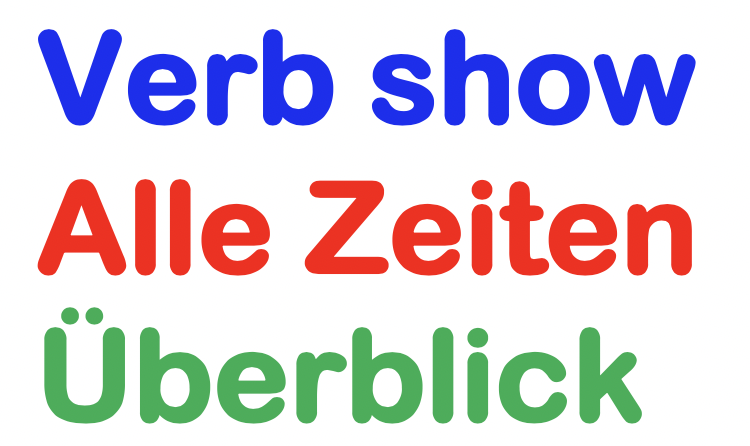Englisch Verb to show konjugieren:
Bilde vom Verb “show” (zeigen) alle Personen in allen Zeiten in Englisch.
Die drei Stammformen lauten: show – showed – shown

Present Simple:
1.P.EZ.: I show
2.P.EZ.: you show
3.P.EZ.: he/she/it shows
1.P.MZ.: we show
2.P.MZ.: you show
3.P.MZ.: they show
Present Progressive
1.P.EZ.: I am showing
2.P.EZ.: you are showing
3.P.EZ.: he/she/it is showing
1.P.MZ.: we are showing
2.P.MZ.: you are showing
3.P.MZ.: they are showing
Past Simple:
1.P.EZ.: I showed
2.P.EZ.: you showed
3.P.EZ.: he/she/it showed
1.P.MZ.: we showed
2.P.MZ.: you showed
3.P.MZ.: they showed
Past Progressive
1.P.EZ.: I was showing
2.P.EZ.: you were showing
3.P.EZ.: he/she/it was showing
1.P.MZ.: we were showing
2.P.MZ.: you were showing
3.P.MZ.: they were showing
Present Perfect Simple
1.P.EZ.: I have shown
2.P.EZ.: you have shown
3.P.EZ.: he/she/it has shown
1.P.MZ.: we have shown
2.P.MZ.: you have shown
3.P.MZ.: they have shown
Present Perfect Progressive
1.P.EZ.: I have been showing
2.P.EZ.: you have been showing
3.P.EZ.: he/she/it has been showing
1.P.MZ.: we have been showing
2.P.MZ.: you have been showing
3.P.MZ.: they have been showing
Past Perfect Simple
1.P.EZ.: I had shown
2.P.EZ.: you had shown
3.P.EZ.: he/she/it had shown
1.P.MZ.: we had shown
2.P.MZ.: you had shown
3.P.MZ.: they had shown
Past Perfect Progressive
1.P.EZ.: I had been showing
2.P.EZ.: you had been showing
3.P.EZ.: he/she/it had been showing
1.P.MZ.: we had been showing
2.P.MZ.: you had been showing
3.P.MZ.: they had been showing
will-Future:
1.P.EZ.: I will show
2.P.EZ.: you will show
3.P.EZ.: he/she/it will show
1.P.MZ.: we will show
2.P.MZ.: you will show
3.P.MZ.: they will show
will-Future Progressive
1.P.EZ.: I will be showing
2.P.EZ.: you will be showing
3.P.EZ.: he/she/it will be showing
1.P.MZ.: we will be showing
2.P.MZ.: you will be showing
3.P.MZ.: they will be showing
going-to-Future Simple:
1.P.EZ.: I am going to show
2.P.EZ.: you are going to show
3.P.EZ.: he/she/it is going to show
1.P.MZ.: we are going to show
2.P.MZ.: you are going to show
3.P.MZ.: they are going to show
going-to-Future Progressive:
1.P.EZ.: I am going to be showing
2.P.EZ.: you are going to be showing
3.P.EZ.: he/she/it is going to be showing
1.P.MZ.: we are going to to be showing
2.P.MZ.: you are going to be showing
3.P.MZ.: they are going to be showing
Future Perfect:
1.P.EZ.: I will have shown
2.P.EZ.: you will have shown
3.P.EZ.: he/she/it will have shown
1.P.MZ.: we will have shown
2.P.MZ.: you will have shown
3.P.MZ.: they will have shown
Future Perfect Progressive:
1.P.EZ.: I will have been showing
2.P.EZ.: you will have been showing
3.P.EZ.: he/she/it will have been showing
1.P.MZ.: we will have been showing
2.P.MZ.: you will have been showing
3.P.MZ.: they will have been showing
Conditional Present:
1.P.EZ.: I would show
2.P.EZ.: you would show
3.P.EZ.: he/she/it would show
1.P.MZ. we would show
2.P.MZ. you would show
3.P.MZ. they would show
Conditional Present Progressive:
1.P.EZ.: I would be showing
2.P.EZ.: you would be showing
3.P.EZ.: he/she/it would be showing
1.P.MZ. we would be showing
2.P.MZ. you would be showing
3.P.MZ. they would be showing
Conditional Perfect:
1.P.EZ.: I would have shown
2.P.EZ.: you would have shown
3.P.EZ.: he/she/it would have shown
1.P.MZ. we would have shown
2.P.MZ. you would have shown
3.P.MZ. they would have shown
Conditional Perfect Progressive:
1.P.EZ.: I would have been showing
2.P.EZ.: you would have been showing
3.P.EZ.: he/she/it would have been showing
1.P.MZ. we would have been showing
2.P.MZ. you would have been showing
3.P.MZ. they would have been showing
